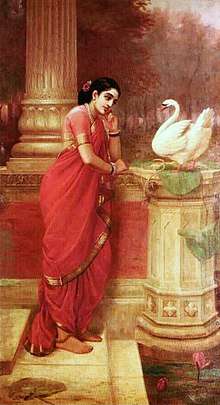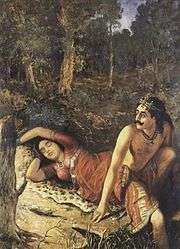Damayanti
Damayanti (Sanskrit: दमयंती) is a character in a love story found in the Vana Parva book of the Mahabharata.[1] She was a princess of the Vidarbha Kingdom, who married King Nala of the Nishadha Kingdom. The character is also found in other Hindu texts by many authors in numerous Indian languages.[2] She, along with Nala, are the central characters in the 12th century text Nishadha Charita, one of the five mahakavyas (great epic poems) in the canon of Sanskrit literature,[3][4]:136 written by Sriharsha.
- For people with the name, see Damayanti (given name)
| Damayanti | |
|---|---|
| Mahabharata character | |
 Damayanti and the swan | |
| In-universe information | |
| Affiliation | Character of Mahabharata |
| Spouse | Nala |
Gallery
 Damayanti and the Swan
Damayanti and the Swan Damayanti choosing her husband
Damayanti choosing her husband "Nala-Damayanti", A painting by Raja Ravi Varma
"Nala-Damayanti", A painting by Raja Ravi Varma
Translations
Norman Mosley Penzer translated the tale of Nala and Damayanti in 1926 into English.[5]
gollark: This one, anyway.
gollark: Yes.
gollark: There's a "foes vanquished" counter on the points page too.
gollark: Yeeees.
gollark: Also, got ideas for games to install on the offline page?
References
- J. A. B. van Buitenen (1981). The Mahabharata, Volume 2. University of Chicago Press. pp. 318–322. ISBN 978-0-226-84664-4.
- Roshen Dalal (2010). Hinduism: An Alphabetical Guide. Penguin Books. pp. 109, 191, 282, 316. ISBN 978-0-14-341421-6.
- The Indian Encyclopaedia. Genesis Publishing. p. 5079.
- C.Kunhan Raja. Survey of Sanskrit Literature. Bharatiya Vidya Bhavan. pp. 136, 146–148.
- S. M. E. (April 1927). "Nala and Damayanti by Norman M. Penzer". The Journal of the Royal Asiatic Society of Great Britain and Ireland (2): 363–364. JSTOR 25221149.
Further reading
- Goswami, B.N. (2015). Nala and Damayanti: A Great Series of Paintings of an Old Indian Romance. Niyogi Books. ISBN 9789383098897.CS1 maint: ref=harv (link)
- Dallapiccola, Anna Libera (2002). Dictionary of Hindu Lore and Legend. Thames & Hudson. ISBN 978-0-500-51088-9.CS1 maint: ref=harv (link)
- Doniger, Wendy (1999). "Chapter 3: Nala and Damayanti, Odysseus and Penelope". Splitting the Difference: Gender and Myth in Ancient Greece and India. University of Chicago Press. pp. 133–204. ISBN 978-0-226-15640-8.CS1 maint: ref=harv (link)
External links
| Wikiquote has quotations related to: Damayanti |
- The Naishadha-charita (story of Nala and Damayanti) English translation by K. K. Handiqui [proofread] (includes glossary)
- Story of Nala and Damayanti English Translation
- Story of Nala and Damayanti from Mahabharata
This article is issued from Wikipedia. The text is licensed under Creative Commons - Attribution - Sharealike. Additional terms may apply for the media files.
